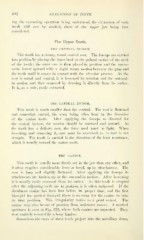Page 604 - My FlipBook
P. 604
602 EXTRACTION OF ThETH.
intr the extractin<>: operation heinti; understood, the extraction of each
tooth will now be studied, those of the n})])er jaw beino; first
considered.
The Upper Teeth.
THE CENTRAL INCISOR.
This tooth has a stron<>:, round conical root. The force[)s are carried
into position bv ])laein
ment forced ujnvard with a slight rotary motion between the ginn and
the tooth until it comes in contact with the alveolar process. As the
root is round and conical, it is loosened by rotation and the out-and-
in motion and then removed by drawing it directly from its socket.
It is, as a rule, easily extracted.
THE LATERAL INCISOR.
This tooth is much smaller than the central. The root is flattened
and somewhat curved, the apex being often bent in the direction
of the canine teeth. After applying the forceps as directed for
the central incisor, the motion should })e outward and inward. As
the tooth has a delicate root, the force used must be light. When
loosening and removing it, care must be exercised, as its root is not
straight. The tooth is carried in the direction of the least resistance,
which is usually toward the canine tooth.
THE CANINE.
This tooth is usually more firmly set in the jaw than any other, and
it often requires considerable force to break up its attachments. The
root is long and slightly flattened. After applying the forceps its
attachments are broken up by the out-and-in motion. After loosening
it is usually easily removed from its socket. As this tooth is erupted
after the adjoining teeth are in position, it is often malposed. If the
deciduous canine has been lost before its proper time, and the first
bicuspid has pushed forward, there is no room for the canine to take
its true position. This irregularity varies to a great extent. The
canine may also be out of position from unknown causes. A marked
specimen is seen in Fig. 535, where both canines are im])acted. They
were entirely covered by a bony lamina.
Sometimes the roots of these teeth project into the mjlxillary sinus,


